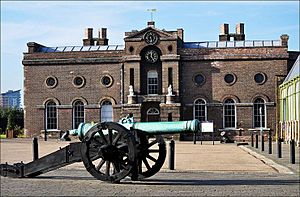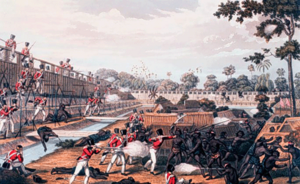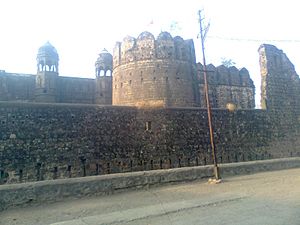Alexander Lindsay (East India Company officer) facts for kids
Quick facts for kids
Sir
Alexander Lindsay
KCB
|
|
|---|---|
| Born | 14 January 1785 |
| Died | 22 January 1872 (aged 87) |
| Allegiance | |
| Service/ |
|
| Years of service |
|
| Rank |
|
| Unit |
|
| Battles/wars |
|
| Spouse(s) | Flora Loudon Mackenzie |
General Sir Alexander Lindsay (born January 14, 1785, died January 22, 1872) was a brave officer. He served in two armies: the British Army and the army of the East India Company. The East India Company was a powerful British trading company. It also had its own army in India.
Lindsay joined the British Army when he was only nine years old. His first regiment was disbanded in 1795. After that, he was put on "half-pay." This meant he received a small payment but was not actively serving. He remained a lieutenant in the British Army for his whole life.
In 1804, Lindsay joined the Bengal Army of the East India Company. He became an artillery officer. Artillery officers are in charge of cannons and other large guns. He fought in several wars and battles. These included the Anglo-Nepalese War (1814–16), the Third Anglo-Maratha War (1817–18), and the First Anglo-Burmese War (1824–26). He was injured in one battle.
Lindsay also had important jobs outside of fighting. He was in charge of telegraphs and making gunpowder. He rose through the ranks. He became a major-general in 1838, a lieutenant-general in 1851, and a full general in 1859. When the East India Company's army became part of the British Army in the 1860s, Lindsay's general rank transferred. This meant he held two British Army ranks at the same time: a lieutenant and a general. This was very unusual!
Contents
Early Life and First Army Steps
Alexander Lindsay was born on January 14, 1785. He was the second son of Ann and James Smyth Lindsay. His family was connected to the Lindsay baronets. His older brother, Martin Lindsay, also became a colonel in the army.
When Alexander was just nine years old, on January 9, 1795, he was made an ensign. An ensign was a very junior officer rank. He joined a British Army unit called Meyrick's Independent Company of Foot. Soon after, on March 3, 1795, he moved to the 104th Regiment of Foot. He was also promoted to lieutenant.
His regiment was stationed in Ireland. However, army checks found it was not meeting standards. So, it was disbanded later that year. When this happened, Lindsay was officially moved to a different, older 104th Regiment that had already been disbanded. This is how he ended up on "half-pay." He stayed a half-pay lieutenant in the British Army for the rest of his life.
Serving the East India Company
Learning to be an Officer
From January 1800, Lindsay studied at the Royal Military Academy, Woolwich. This academy trained officers for the British Army, especially for engineering and artillery roles. Many students also went on to join the armies of the East India Company.
Lindsay finished his training in February 1804. On August 14, 1804, he joined the East India Company's Bengal Army. He started as a first lieutenant in the artillery. His first job was at the Company's base in Calcutta. In March 1805, he moved to Cawnpore (now Kanpur).
Early Battles in India
In September 1805, Lindsay joined a campaign against a local ruler named Kirat Singh. Singh refused to give up his territory. Lindsay's artillery unit helped attack Gohad Fort in February 1806. Their cannons broke down the fort's walls. This allowed the soldiers to capture it. After this, Lindsay was sent to Agra and then back to Cawnpore.
Later, Lindsay commanded cannons in Lucknow. He was promoted to captain-lieutenant in February 1806. In October, he took command of a company in Agra. He fought in a campaign in the Bundelkhand region in 1807-1808. He took part in the siege of Cummonah (now Kamona, Uttar Pradesh). His artillery had to bombard the fort for a month before it surrendered. He also helped capture another fort at Gunnowrie (now Ginauri). Lindsay returned to Agra in January 1808.
In July 1808, Lindsay led an expedition to capture smaller forts in Candoulee (now Kandali, Uttar Pradesh). He succeeded in taking them. He continued to command artillery units in different locations, moving to Mathura and then Fatehgarh. In 1813, he moved to the Bengal Artillery's main base at Dum Dum.
The Anglo-Nepalese War
Lindsay became a captain on March 26, 1813. He was given command of an artillery company. He joined the army for the 1814 campaign of the Anglo-Nepalese War. This war was fought between the East India Company and the Kingdom of Nepal.
Lindsay was part of a larger force led by Major-General David Ochterlony. Lindsay commanded the artillery for his column. He also acted as a field engineer, planning how to attack forts. In February 1816, he found a good spot for cannons to fire on the Nepalese fort at Hurrechurpoor (Hariharpurgadhi). The British took the spot, but the Nepalese fought back hard. In an eight-hour battle, the British pushed them back but lost many soldiers. Lindsay was one of five officers who were wounded. The war ended in March 1816 with a peace treaty.
After recovering from his wounds, Lindsay commanded cannons for a campaign against Daya Ram in March 1817. Ram was a local leader who was rebelling. Lindsay took part in the Siege of Hathras, where the fortress was captured.
Later Roles and Promotions
In September 1817, Lindsay was put in charge of materials for making gun carriages. When the Third Anglo-Maratha War began, he joined the army again. He commanded the artillery for one part of the army. They chased the Marathas and captured several forts. After capturing Saugor (now Sagar), Lindsay returned to his administrative job.
On August 12, 1819, Lindsay was given the honorary rank of major. In November, he became the superintendent of telegraphs between Calcutta and Chunar. Telegraphs were a new way to send messages over long distances. On January 1, 1820, Lindsay married Flora Loudon Mackenzie. They did not have any children. In October 1820, he became the Company's agent for making gunpowder in Allahabad.
Lindsay was promoted to lieutenant-colonel on May 1, 1824. He then commanded the artillery on the Burmese border during the First Anglo-Burmese War (1824-1826). This was his last time serving in a war. He was honored with the Companion of the Order of the Bath award in 1831. He was promoted to colonel in 1835.
Lindsay continued to be promoted in the Bengal Army. He became a major-general in 1838, a lieutenant-general in 1851, and a full general in 1859.
Return to the British Army and Later Life
In the 1860s, after the Indian Mutiny, the East India Company's armies came under the direct control of the British government. Lindsay's general rank was transferred to the British Army. His old lieutenant rank from the 104th Regiment was never canceled. This meant he was listed twice in the British Army's official records. He was both a general and a lieutenant at the same time!
Lindsay received another high honor. He was made a Knight Commander of the Order of the Bath on November 9, 1862. This meant he could use "Sir" before his name.
His wife, Flora, passed away in 1863. Sir Alexander Lindsay himself died from bronchitis at his home in Perth, Scotland, on January 22, 1872. His nephew, Alexander Hadden Lindsay, also became a major-general in the British Army.
Images for kids
See Also
- Alexander Hadden Lindsay







